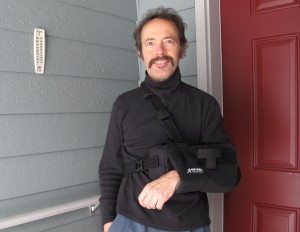More and more Alaskans are heading Outside for major elective surgeries. Flying to the Lower 48 for things like knee and hip replacements can save patients and their health plans tens of thousands of dollars. Health care experts hope the practice will help put pressure on Alaska prices for those surgeries. And there’s some evidence the strategy is working.

Wayne Todd was hiking Flattop this summer when he fell and tore a tendon in his left shoulder. A local orthopedic doctor recommended surgery. Todd called around to figure out how much the surgery would cost. Once he added up the fees for the surgeon, the surgery center, the anesthesiologist, and more, the total came to $47,000.
“I quickly gleaned that costs up here were quite high,” he says.
Todd is self-employed and his health plan comes with a $10,000 deductible. When he called his insurance company, Premera Alaska, they told him he could be on the hook for costs even after the deductible.
“What insurance told me was that they may not even cover 100 percent after the $10,000 deductible because the costs are so high up here,” he says.
So in October, Todd traveled to the University of Washington Medical Center in Seattle for the surgery. The total cost was $14,000 — less than a third of the Alaska price.
Todd is not alone, more Alaskans are going Outside for surgeries. And employers and insurers are making the option much more appealing for patients. Todd had to pay for his own travel to Seattle. But starting in January his insurer, Premera Alaska will pick up all those expenses for members on individual and group plans. Jim Grazko, president of Premera Alaska, is doing whatever he can to encourage patients to head south for surgeries.
“And one of the things we used to require is the member would show that there was at least $4,500 dollars of savings, based on where they would have the procedure done and… we’ve eliminated that requirement.”
Grazko says the travel benefit applies to at least 17 different surgeries. The option isn’t used frequently, but the number of members taking advantage of it is growing quickly. Premera will even act as a travel agent, booking flights and hotel for the patient and a companion.
Many health plans now sweeten the pot even further, waiving deductibles and all out-of-pocket expenses for employees willing to travel for surgeries. That’s the case with the Alaska Teamsters, according to trust administrator Dennie Castillo.
“Any amount that we can save is huge for us,” she says.
Castillo says last year six members traveled Outside for orthopedic surgery. This year, that number jumped to 41. Castillo calculates those 47 people racked up nearly half a million dollars in savings for the health plan.
Castillo says specialty surgery costs in Alaska are excessive. And she hopes the travel puts pressure on those prices:
“I understand we do live in Alaska and prices are higher, healthcare costs are going to be higher, but not to the extent these specialty docs are billing,” she says.
So far the high prices in Alaska are holding firm. But benefits consultants and insurers say orthopedists are starting to agree to negotiated discounts for some health plans, something that was unheard a few years ago.
The two largest orthopedic clinics in Anchorage — Anchorage Fracture and Orthopedic Clinic and Orthopedic Physicians Alaska — declined to comment for this story.
Jeff Ranf is vice president of employee benefits at USI insurance in Anchorage. His firm designs and manages health plans for more than 100 employers in the state. He counsels those employers to convince as many employees as possible to travel Outside for elective surgeries. He says the savings are impressive.
“Gigantic, when you really start to think of the dollars and cents,” he says.
Ranf estimates right now only about 1 percent of plan members are traveling for healthcare. He thinks when that number hits at least 5 percent, specialists in Alaska will start to adjust their prices.
“I think some of these providers are going to start getting the message that they really can’t afford to continue charging these prices,” he says.
As for Wayne Todd, he’s happy with how his surgery went in Seattle. But a few days after returning to Anchorage, he developed blood clots in his right lung, a serious complication, likely due to the plane ride home.
Todd spent one day at Providence hospital in Anchorage recovering, wiping out most of the savings of the trip south. But for Todd, his experience just makes the point that it’s in everyone’s interests to be able to access affordable care at home.
This story is part of a reporting partnership between APRN, NPR and Alaska Public Media.
Annie Feidt is the broadcast managing editor at Alaska Public Media. Reach her at afeidt@alaskapublic.org. Read more about Annie here.





